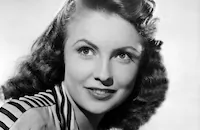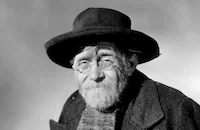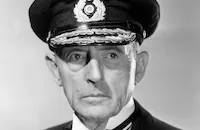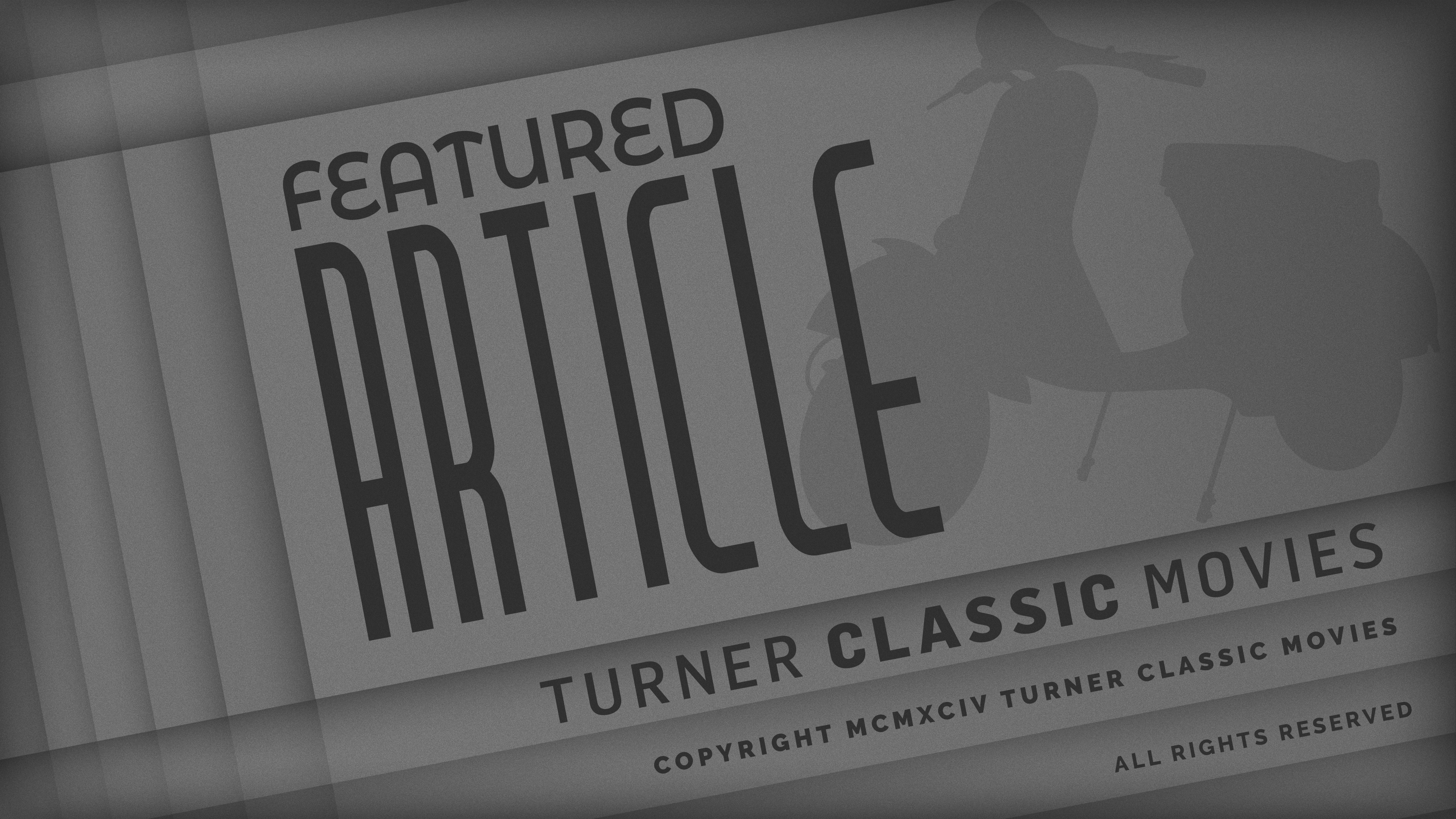Rhapsody in Blue

Brief Synopsis
Cast & Crew
Irving Rapper
Robert Alda
Joan Leslie
Alexis Smith
Charles Coburn
Julie Bishop
Film Details
Technical Specs

Synopsis
When young brothers George and Ira Gershwin are growing up on New York City's Lower East Side, their mother Rose saves enough money to buy a piano, so that Ira, the eldest, can take lessons. George becomes the student, however, when he demonstrates his natural musical abilities. Under the instruction of Professor Frank, George becomes progressively better at the piano. He first obtains a job as a pianist in a vaudeville theater and then in a music store, but his dream is to become a composer. One day singer Julie Adams comes into the store looking for music to use in an audition. George plays "Swanee," one of his own compositions, for her, but when his boss hears him, he loses his job. Later, George is offered a two-year contract at Harms, another music publisher, and Max Dreyfus, the company head, sells "Swanee" to Al Jolson, who makes it a hit. Despite Frank's warning against squandering his talents on popular music, George takes a job writing songs for the Broadway show Half Past Eight , starring Julie, but the show fails. After the success of George White's Scandals of 1921 , for which George writes the music, his career takes off, and together with Ira, who now writes lyrics, George composes a series of hit shows. After George writes "Blue Monday Blues," a song derived from Negro spirituals, which is not well received, conductor Paul Whiteman asks him to compose a serious piece based on the blues for a jazz concert he is planning, The result is Rhapsody in Blue , and upon hearing his prize pupil's composition being performed for a radio broadcast, Professor Frank dies. Later, when Walter Damrosch of the New York Symphony commissions a concerto from him, George goes to Paris to begin a serious study of music. There he meets wealthy painter Christine Gilbert, who introduces him to Maurice Ravel and other composers. The slightly older Christine and George return to the United States, causing a jealous Julie a great deal of pain. Realizing that George is more in love with his music than with her, Christine leaves George and, after composing another Broadway show, George returns to Paris and completes his concerto. George's father dies of leukemia after advising his son that he was wrong to separate from Julie. While living in Los Angeles, George begins to compose frantically. He wins a Pulitzer prize for the musical Of Thee I Sing and writes Porgy and Bess , an opera featuring black performers. Later, George experiences numbness and headaches. After he collapses during a rehearsal, Julie plans to come to California immediately. In New York, George's friend, Oscar Levant, then performs George's Concerto in F to great acclaim, but the occasion is saddened by the announcement of the composer's untimely death.

Director

Irving Rapper
Cast

Robert Alda

Joan Leslie

Alexis Smith

Charles Coburn

Julie Bishop

Albert Basserman

Morris Carnovsky

Rosemary Decamp

Oscar Levant

Paul Whiteman

Al Jolson
George White
Hazel Scott
Anne Brown
Herbert Rudley
John B. Hughes
Mickey Roth

Darryl Hickman

Charles Halton
Andrew Tombes
Gregory Golubeff
Walter Soderling
Eddie Marr
Theodore Von Eltz
Bill Kennedy
Johnny Downs
Ernest Golm
Martin Noble
Hugo Kirchhoffer

Will Wright
Tom Patricola
Robert Sayne
George Riley
Virginia Sale
Tom Stevenson
Yola D'avril
Claire Dubrey

Christian Rub
Esther Michelson
Robert Wilbur
Ivan Lebedeff
Odette Myrtil
Jay Novello
Leroy Antoine
Jack Chefe
Charles Waldron

Lillian Bronson
John Henry Morton
Sam Savitsky
Broderick O'farrell
Robert Johnson
William Gillespie
Ernie Adams
John Dilson
Armand Cortes
Jacques Lory
Edward Harvey
"big" Ben Moroz
Jesse Graves
Oliver Prickett
Carl Neubert
Clay Womack
Frank Pharr
Kate Harrington
Walter White
Bernard Deroux
Fred Dosh
Harry Seymour
Joe Sullivan
Clarence Badger Jr.

Frank Reicher
Georges Renavent

Lynne Baggett
Elsa Basserman
Constance Purdy
Caroline Burke
Milton Mack
Joan Winfield
Ralph Mccolm
Nellie V. Nichols
Al Gallodoro
Crew
Milo Anderson
Lou Baum
Folmer Blangsted
Einar H. Bourman
Irving Caesar
J. Will Callahan
Meta Carpenter
Dudley Chambers
Harry Chandlee
Geraldine Cole
Roy Davidson
B. G. Desylva
Roy Dumont
Clarence Eurist
Frank Evans
Leo F. Forbstein
David Forrest
Al Gallodoro
Katherine Garabedian
George Gershwin
Ira Gershwin
Merritt Gerstad
Morris Goldman
Al Greene
Ferde Grofe
Anton Grot
Ernest Haller
Ray Heindorf
Dubose Heyward
John Hughes
Felix Jacoves
Stanley Jones
Howard Koch
Jesse L. Lasky
James Leicester
Oscar Levant
Sonya Levien
Nathan Levinson
Ballard Macdonald
Fred M. Maclean
Mickey Marigold
Harold Noyes
Charles O'bannon
Clifford Odets
Elliott Paul
Jim Peters
Sol Polito
Leroy Prinz
Lee G. Roberts
Robert Rossen
Ted Schultz
Tillie Starrett
Max Steiner
Joe Stinton
Jeanette Storck
Sally Sweetland
Ray Turner
Willard Van Enger
Bob Vreeland
William Wallace
Jack L. Warner
Perc Westmore
Paul Whiteman

Videos
Movie Clip






Trailer
Film Details
Technical Specs

Award Nominations
Best Score
Best Sound
Articles
Rhapsody in Blue
- Oscar Levant's comment on how far the film Rhapsody in Blue veered from the truth about George Gershwin's life.
Hollywood had expressed interest in doing a biography of America's most influential modern composer ever since his untimely death in 1937, but it took eight years to finally get the story on the screen. Part of that time was consumed in legal affairs, obtaining the rights to the Gershwin musical library, but it was just as difficult coming up with a screenplay from a life that was notably devoid of conflict. If what they ended up with was a fiction with the Gershwin name attached, at least Rhapsody in Blue (1945) featured 22 of his greatest songs and excerpts from five of his instrumental pieces, performed by such noted Gershwin interpreters as pianist Oscar Levant, singers Al Jolson and Anne Brown and conductor Paul Whiteman.
Various writers on the Warner Bros. lot labored over the story for years. When playwright Clifford Odets took over the project, he drove his fellow writers crazy playing recordings of Gershwin's music all day to get in the mood. The result was an 800-page screenplay about class struggle, featuring the young Gershwin's battle to rise from poverty to gain international acceptance as a composer. Most readers thought it was more about Odets than Gershwin, so Warners assigned another writer to the project and used portions of Odets' screenplay a year later for another picture with a musical background, Humoresque.
What stymied most of the writers was the lack of dramatic material in Gershwin's life. It wasn't that his life was devoid of romance. He was rumored to have had flings with everyone from Adele Astaire to Fay Wray. Friends noticed that he was always proposing to beautiful women, none of whom took him seriously. After his death, a gold-plated key to French actress Simone Simon's Hollywood home was found among his possessions. None of that was considered screen-worthy, so writers Sonya Levien, Elliot Paul and Howard Koch created two fictional romances for the film, one with a young singer (Joan Leslie), the other with a society woman (Alexis Smith), both of whom leave the driven Gershwin rather than compete with his career. With no major setbacks in his career, the writers magnified the importance of "Blue Monday Blues," a one-act opera dropped from George White's Scandals in 1924, and used it as motivation for Gershwin's first serious piece, "Rhapsody in Blue."
To make up for all the fiction in the screenplay, the studio spared no expense on creating the trappings of authenticity. They borrowed several of Gershwin's personal belongings -- including his worktable, a silent piano keyboard he used when he traveled and even some of his paintings -- from his brother, lyricist Ira Gershwin, who also served as a consultant on the production. The art department re-created some of the most famous theatres and concert venues in Gershwin's career, including Aeolian Hall, where "Rhapsody in Blue" premiered; the Los Angeles Philharmonic Auditorium, the Comedie-Francaise and the Winter Garden, Music Box and Apollo Theatres. For the Porgy and Bess sequence they built an exact reproduction of the opera's original stage setting. They also hired several performers who had introduced Gershwin's music to the world, including Anne Brown, who had sung in both "Blue Monday Blues" and the premiere of Porgy and Bess. Al Jolson, who had introduced Gershwin's first hit, "Swanee," in the musical Sinbad, performed the number in the same costume he had worn in that 1917 show. When band leader Paul Whiteman, who had commissioned and conducted the first performance of "Rhapsody in Blue," showed up for his scenes, the makeup department had to shave off his mustache to put on a fake one more like the style he wore in 1924. Since he'd lost weight recently, the costume department added padding to his clothing so he would look more like himself.
The wisest choice Warners made in seeking authenticity was hiring longtime Gershwin friend Oscar Levant, who at the time was considered the premier interpreter of his works. Not only did Levant record the performance of "Rhapsody in Blue" and "Concerto in F" used in the film, but also he played himself. Some critics even suggested that he had written his own lines. Certainly, his presence -- and his acerbic one-liners -- helped capture the sophistication of the era in which Gershwin reached the height of his fame.
Rhapsody in Blue was one of Warner Brothers' biggest hits of 1945. It did so well, the studio followed much the same formula in filming their 1946 Cole Porter biography, Night and Day (even down to casting a friend of the composer's, this time Monty Woolley, to provide comic relief). It also provided a smashing screen debut for its star, Robert Alda, who delivered a strong performance as Gershwin. Alda would go on to still greater fame as a Broadway musical star, particularly as the original Skye Masterson in Guys and Dolls, before watching his son, Alan Alda, rise to even greater heights.
Producer: Jesse L. Lasky
Director: Irving Rapper
Screenplay: Howard Koch, Elliot Paul
Based on a story by Sonya Levien
Cinematography: Sol Polito
Art Direction: John Hughes, Anton Grot
Music: Ray Heindorf, Max Steiner
Principal Cast: Robert Alda (George Gershwin), Joan Leslie (Julie Adams), Alexis Smith (Christine Gilbert), Julie Bishop (Lee Gershwin), Albert Bassermann (Prof. Frank), Morris Carnovsky (Poppa Gershwin), Rosemary DeCamp (Momma Gershwin), Herbert Rudley (Ira Gershwin), Darryl Hickman (Ira Gershwin as a Boy), Oscar Levant, Al Jolson, Anne Brown, Paul Whiteman, George White, Hazel Scott (Themselves).
BW-142m. Closed captioning.
by Frank Miller

Rhapsody in Blue
Quotes
Trivia
Louanne Hogan dubbed Joan Leslie's singing
The Catfish Row set seen in the "Porgy and Bess" sequence is an exact duplicate of the original 1935 set for the first Broadway production of the opera.
Notes
George Gershwin was born in Brooklyn, New York on September 26, 1898. As depicted in the film, he began his musical career selling songs for the Remick publishing company when he was sixteen years old. Later he worked as a rehearsal pianist. When he was twenty, he was commissioned to write the score for La La Lucille and then wrote the music for five of George White's Scandals. He attracted the attention of serious composers with Rhapsody in Blue, which was first played by Paul Whiteman at the Aeolian Hall on February 12, 1924. His opera Porgy and Bess was the first to use an all-black cast. Although Gershwin had many romantic attachments, there was no counterpart in his life to the character of "Julie." He died of a brain tumor at age 38 on 11 July 1937.
This film marked the motion picture debuts of Broadway actors Robert Alda and Herbert Rudley. Although Daily Variety lists the preview running time as 143 minutes, the Variety review gives a running time of 130 minutes. In the film, Al Jolson sings "Swanee," the song he made famous, and Anne Brown, the original "Bess," sings "Summertime" from the opera Porgy and Bess. According to Variety, the unbilled Tom Patricola "reprises 'Somebody Loves Me' as he did in 'Scandals.'" Paul Whiteman also re-creates some of his real-life numbers. Press releases included in the file on the film at the AMPAS Library add the following information about the production: Clifford Odets wrote an early version of the screenplay and Robert Rossen was at one time assigned to work on the script from an outline prepared by Ira Gershwin and Kathryn Scola. (Although Odets and Rossen are mentioned in production files for the film, Scola is not.) Five original paintings from George Gershwin's personal art collection were loaned to Warner Bros. for use in the film. These included "Army Doctor" by Amedeo Modigliani; "Abstraction" by Antoine Masson; Georges Roualt's "Three Clowns;" and Maurice de Vlaminck's "Near Paris." Another press release notes that John Garfield was tested for the lead. An July 8, 1945 New York Times article reports that Oscar Levant wanted the filmmakers to include a scene in which he quarrels with George Gershwin-as he frequently did-but the studio thought that an argument would put too much strain on the relationship between the two men as depicted in the film. Hollywood Reporter news items add the following information about the production: Cary Grant was considered for the role of "George Gershwin." Kay Swift worked with Ira Gershwin on the musical arrangements. Oscar Levant dubbed Robert Alda's piano playing. Several theaters, including The Apollo, the Aeolian Hall, Times Square Theater, The Music Box, Carnegie Hall, Lewisohn Stadium, the Los Angeles Philharmonic Auditorium and His Majesty's Theatre in London, were recreated for the film. Nathan Levinson's sound recording was nomimated for an Oscar as was Ray Heindorf and Max Steiner's score. Gershwin's Variety obituary notes that the rights to most of his music were controlled by the Warner Bros. publishing group. In 1946, Hollywood Reporter reported that Chico Marx sued Warner Bros for $200,000 for damages and "payment owed for services rendered." Marx alleged that the filmmakers used his name "many times" in the film. Studio officials admitted that Marx's name had been used in the film, but were unclear about what services the comedian had rendered. The disposition of the suit is not known.
The film received Academy Award nominations in the Music (Scoring of a Musical Picture) and Sound Recording categories. Although modern sources state that Joan Leslie's singing voice was dubbed by Louanne Hogan, Leslie's voice was actually dubbed by Sally Sweetland.















